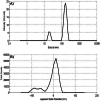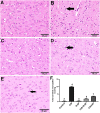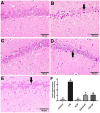Neuroprotective Potential of Intranasally Delivered Sulforaphane-Loaded Iron Oxide Nanoparticles Against Cisplatin-Induced Neurotoxicity
- PMID: 35969308
- PMCID: PMC9515146
- DOI: 10.1007/s12640-022-00555-x
Neuroprotective Potential of Intranasally Delivered Sulforaphane-Loaded Iron Oxide Nanoparticles Against Cisplatin-Induced Neurotoxicity
Abstract
Cisplatin (CIS) is a platinum-based chemotherapeutic drug that is widely used to treat cancer. However, its therapeutic efficiency is limited due to its potential to provoke neurotoxicity. Sulforaphane (SF) is a natural phytochemical that demonstrated several protective activities. Iron oxide nanoparticles (Fe3O4-NPs) could be used as drug carriers. This study aimed to explore the nanotoxic influence of SF-loaded within Fe3O4-NPs (N.SF), and to compare the neuroprotective potential of both N.SF and SF against CIS-induced neurotoxicity. N.SF or SF was administrated intranasally for 5 days before and 3 days after a single dose of CIS (12 mg/kg/week, i.p.) on the 6th day. Neuromuscular coordination was assessed using hanging wire and tail-flick tests. Acetylcholinesterase (AChE) activities and markers of oxidative stress were measured in the brain. In addition, the brain iron (Fe) content was estimated. CIS significantly induced a significant increase in AChE activities and lipid peroxides, and a significant decrement in glutathione (GSH) and nitric oxide (NO) contents. CIS elicited impaired neuromuscular function and thermal hyperalgesia. CIS-induced brains displayed a significant reduction in Fe content. Histopathological examination of different brain regions supported the biochemical and behavioral results. Contradict, treatment of CIS-rats with either N.SF or SF significantly decreased AChE activity, mitigated oxidative stress, and ameliorated the behavioral outcome. The histopathological features supported our results. Collectively, N.SF demonstrated superior neuroprotective activities on the behavioral, biochemical, and histopathological (striatum and cerebral cortex) aspects. N.SF could be regarded as a promising "pre-clinical" neuroprotective agent. Furthermore, this study confirmed the safe toxicological profile of Fe3O4-NPs.
Keywords: Acetylcholinesterase; Cisplatin; Intranasal; Iron oxide nanoparticles; Neurotoxicity; Sulforaphane.
© 2022. The Author(s).
Conflict of interest statement
The authors declare no competing interests.
Figures












Similar articles
-
Neurotherapeutic efficacy of loaded sulforaphane on iron oxide nanoparticles against cuprizone-induced neurotoxicity: role of MMP-9 and S100β.Toxicol Mech Methods. 2023 Nov;33(6):463-479. doi: 10.1080/15376516.2023.2177219. Epub 2023 Feb 12. Toxicol Mech Methods. 2023. PMID: 36775846
-
Effects of protocatechuic acid against cisplatin-induced neurotoxicity in rat brains: an experimental study.Int J Neurosci. 2024 Jul;134(7):725-734. doi: 10.1080/00207454.2022.2147430. Epub 2022 Dec 16. Int J Neurosci. 2024. PMID: 36525373
-
Effect of curcumin nanoparticles on the cisplatin-induced neurotoxicity in rat.Drug Chem Toxicol. 2019 Mar;42(2):194-202. doi: 10.1080/01480545.2018.1504058. Epub 2018 Sep 27. Drug Chem Toxicol. 2019. PMID: 30257586
-
Quercetin attenuates neurotoxicity induced by iron oxide nanoparticles.J Nanobiotechnology. 2021 Oct 18;19(1):327. doi: 10.1186/s12951-021-01059-0. J Nanobiotechnology. 2021. PMID: 34663344 Free PMC article. Review.
-
Sulforaphane and Brain Health: From Pathways of Action to Effects on Specific Disorders.Nutrients. 2025 Apr 15;17(8):1353. doi: 10.3390/nu17081353. Nutrients. 2025. PMID: 40284217 Free PMC article. Review.
Cited by
-
Berberine-loaded iron oxide nanoparticles alleviate cuprizone-induced astrocytic reactivity in a rat model of multiple sclerosis.Biometals. 2025 Feb;38(1):203-229. doi: 10.1007/s10534-024-00648-4. Epub 2024 Nov 14. Biometals. 2025. PMID: 39543075 Free PMC article.
-
The therapeutic potential of 1, 25-dihydroxy vitamin D3 on cisplatin-affected neurological functions is associated with the regulation of oxidative stress and inflammatory markers as well as levels of MMP2/9.Metab Brain Dis. 2024 Aug;39(6):1189-1200. doi: 10.1007/s11011-024-01382-z. Epub 2024 Jul 17. Metab Brain Dis. 2024. PMID: 39017968
-
Comprehensive Analysis of the Potential Toxicity of Magnetic Iron Oxide Nanoparticles for Medical Applications: Cellular Mechanisms and Systemic Effects.Int J Mol Sci. 2024 Nov 8;25(22):12013. doi: 10.3390/ijms252212013. Int J Mol Sci. 2024. PMID: 39596080 Free PMC article. Review.
-
Natural products for the treatment of chemotherapy-related cognitive impairment and prospects of nose-to-brain drug delivery.Front Pharmacol. 2024 Jan 29;15:1292807. doi: 10.3389/fphar.2024.1292807. eCollection 2024. Front Pharmacol. 2024. PMID: 38348396 Free PMC article. Review.
-
Neurotoxicity of the antineoplastic drugs: "Doxorubicin" as an example.J Mol Histol. 2024 Dec;55(6):1023-1050. doi: 10.1007/s10735-024-10247-9. Epub 2024 Oct 1. J Mol Histol. 2024. PMID: 39352546 Review.
References
-
- Ali BH, Ramkumar A, Madanagopal TT, Waly MI, Tageldin M et al (2014) Motor and behavioral changes in mice with cisplatin-induced acute renal failure. Physiological Res 63(1) - PubMed
MeSH terms
Substances
LinkOut - more resources
Full Text Sources
Other Literature Sources

